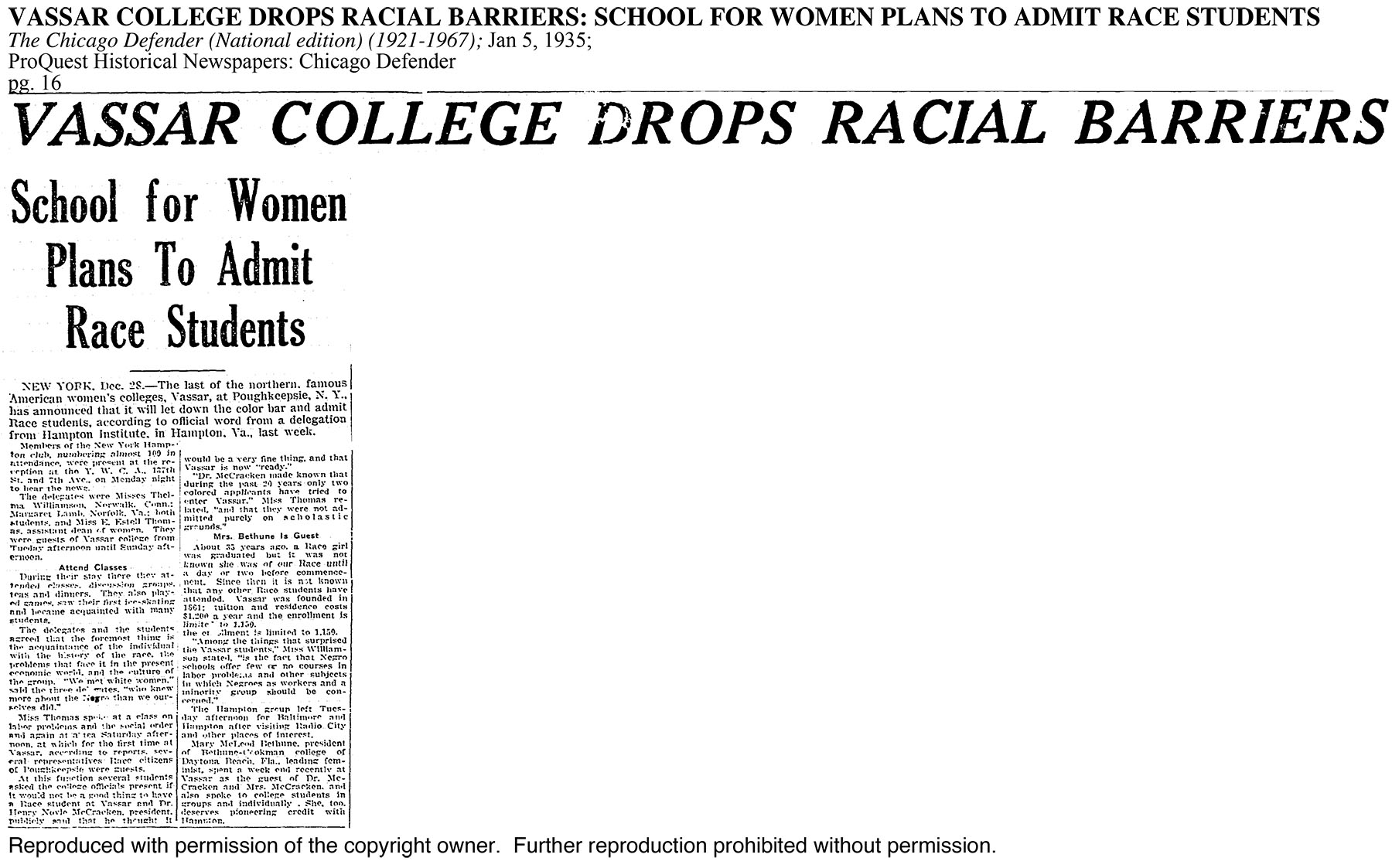This article published on December 28, 1935 reveals the landmark decision for Vassar to admit Black students. The article cites that President MacCracken felt that Vassar was “ready” to take this step. It also states that he claimed only two Black students applied to Vassar since he had become president and that they were only turned away on “scholastic grounds.” This seems to be a way to deny responsibility for Vassar’s exclusion. MacCracken, instead of owning up to Vassar’s racist past and promising to do better, blamed the lack of diversity on the grounds of merit. It highlights a lack of ownership on Vassar administration’s inequality. Despite Vassar pledging to admit Black students, it was not until 1940 that the first official student of color was admitted to Vassar.

Full Article
Vassar College Drops Racial Barriers: School for Women Plans to Admit Race Students
The Chicago Defender (National edition) (1921–1967);
Jan 5, 1935;
ProQuest Historical Newspapers: Chicago Defender
pg. 16
NEW YORK, Dec. 28—The last of the northern, famous American women’s colleges, Vassar, at Poughkeepsie, N.Y., has announced that it will let down the color bar and admit Race students, according to official word from a delegation from Hampton Institute, in Hampton, Va., last week.
Members of the New York Hampton club, numbering almost 100 in attendance, were present at the reception at the Y.W.C.A., 137th St. and 7th Ave, on Monday night to hear the news.
The delegates were Misses Thelma Williamson, Norwalk, Conn.; Margaret Lamb, Norfolk, Va.; both students, and Miss E. Estell Thomas, assistant dean of women. They were guests of Vassar College from Tuesday afternoon until Sunday afternoon.
Attend Classes
During their stay there they attended classes, discussion groups, teas and dinners. The also played games, saw their first ice-skating and became acquainted with many students.
The delegates and the students agreed that the foremost thing is the acquaintance of the individual with the history of the race, the problems that face it in the present economic world, and the culture of the group. “We met white women,” said the three delegates. “who knew more about the Negro than we ourselves did.”
Miss Thomas spoke at a class on labor problems and the social order and again at a tea Saturday afternoon, at which for the first time at Vassar, according to reports, several representatives Race citizens of Poughkeepsie were guests.
At this function several students asked the college officials present if it would not be a good thing to have a Race student at Vassar and Dr. Henry Noyle McCracken, president publicly said that he thought it would be a very fine thing, and that Vassar is now “ready.”
“Dr. McCracken made known that during the past 20 years only two colored applicants have tried to enter Vassar.” Miss Thomas related, “and that they were not admitted purely on scholastic grounds.”
Mrs. Bethune Is Guest
About 35 years ago, a Race girl was graduated but it was not known she was of our Race until a day or two before commencement. Since then it is not known that any other Race students have attended. Vassar was founded in 1861: tuition and residence costs $1,200 a year and the enrollment is limited to 1,150. the enrollment is limited to 1,150.
“Amon the things that surprised the Vassar students,” Miss Williamson stated, “is the fact that Negro schools offer few or no courses in labor problems and other subjects in which Negroes as workers and a minority group should be concerned.”
The Hampton group left Tuesday afternoon for Baltimore and Hampton after visiting Radio City and other places of interest.
Mary Mcleod Bethune, president of Bethune-Cookman college of Daytona Beach, Fla., leading feminist, spent a week end recently at Vass as the guest of Dr. McCracken and Mrs. McCracken, and also spoke to college students in groups and individually. She, too, deserves pioneering credit with Hampton.
Vassar College Drops Racial Barriers original article (PDF, 51KB)
Reproduced with permission of the copyright owner. Further reproduction prohibited without permission.

